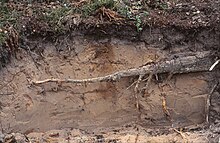Regosol
A Regosol (from Greek : "rhegos" = blanket, to cover) is a shallow soil , which forms in an early stage of soil development on lime-free to lime-poor loose material; this is classically sand . The soil type has two horizons and is divided into class R (Ah / C soils ) in the German soil systematics . Its abbreviation is RQ.
In the World Reference Base for Soil Resources (WRB) there is a reference soil group , which is also called Regosol , but is defined somewhat differently and in some cases includes soils that in the German system belong to the loose syrosemes , the pararendzines and the rendzines .
Origin and Distribution
Sand is the classic starting material for regosols, as other loose materials with little or no lime are extremely rare. If this is on the surface, there is initially only a horizon ("pure sand"). As soon as there is a colonization with plants , humus forms , so that a second horizon ("humus sand") forms on the surface. This initial stage is known as locksyrosema . As soon as the humus horizon reaches a thickness of more than 2 cm, the soil is a regosol. However, this does not mean that soil development is over. In the further course the weathering leads to browning and silting , so that a B-horizon is formed and the next stage is reached (nutrient-poor brown earth ). At the end of the soil development there is the Podsol .
In Central Europe , regosols only occur on young surfaces, as they develop relatively quickly into brown soils and podzols in the course of soil development. Long-term or even permanent regosols are only found on sites prone to erosion. These are primarily coastal dunes in the gray dune stage . In addition, regosols are widely used these days due to human activity. Primarily on eroded areas due to inappropriate use. Relocation of material in the course of civil engineering or military training areas with sandy subsoil can also be mentioned.
Worldwide, regosols are widespread in arid areas with sandy deserts and semi-deserts . Because of the low biomass production and constant wind erosion, they are often the final stage of soil formation.
Leveling
According to the German soil system, the Regosol has the leveling Ah / ilC.
- Ah: The topsoil horizon (A) is humic (h). It has a thickness of at least 2 cm and a maximum of 40 cm (average 10–20 cm). The term Ap (p = plowed) can also appear under agricultural use.
- ilC: The starting material (C) is loose (l) and low in lime to lime-free (i = silicate ; ≤ 2 % by weight lime ). Usually it is sand. The material is largely unweathered and must be at least 30 cm thick.
properties
Sand can hardly store water and nutrients . Regosols are therefore at risk for drought stress and nutrient deficiency. Because of the single grain structure of sand, the material is very susceptible to erosion. The advantages of sand are good machinability, rootability, ventilation and heatability. The pH value can fluctuate widely. They are very low on most of the sands; only very high on the coast because of the mussel shells . Due to the low nutrient retention capacity of sand, however, decalcification occurs quickly, so that the values decrease over time.
use
Regosols can in principle be used for agriculture. Due to the properties of the sandy raw material (lack of nutrients, low pH values, erodibility and poor water retention capacity), the expected yield is low and uncertain. Cultures are cultivated with low demands ( rye ), those that prefer loose, warm soils ( asparagus , potatoes ) or generalists ( maize ). Possible measures for better use of arable land include: B. irrigation , regular and adapted fertilization or humus enrichment through organic fertilization (improvement of the holding capacity of nutrients and water). In particular, the protection against erosion must be taken into account, especially if the Regosol in question was created through erosion.
Sandy soils are often used for forestry in Central Europe ( pines ).
In the dune areas of the coast, use is neither possible nor appropriate. The dune belt is important for nature and coastal protection .
Other Ah / C floors
In addition to the Regosol, three other soil types belong to the class of Ah / C soils, which differ diagnostically mainly in the lime content of the starting material:
- The pararendzina arises on marly material (carbonate content> 2% by mass and <75% by mass). Mostly it is loose rock materials such as loess .
- The tendril also forms on material with little or no lime (carbonate content ≤ 2% by mass). However, it must be solid rock .
- The Rendzina lies on lime-rich materials (carbonate content ≥ 75% by mass) such as limestone or gypsum .
literature
- W. Amelung, H.-P. Blume , H. Fleige, R. Horn, E. Kandeler , I. Kögel-Knabner , R. Kretschmar, K. Stahr , B.-M. Wilke: Scheffer / Schachtschabel textbook of soil science. 17th edition. Heidelberg 2018. ISBN 978-3-662-55870-6 .
